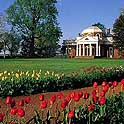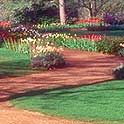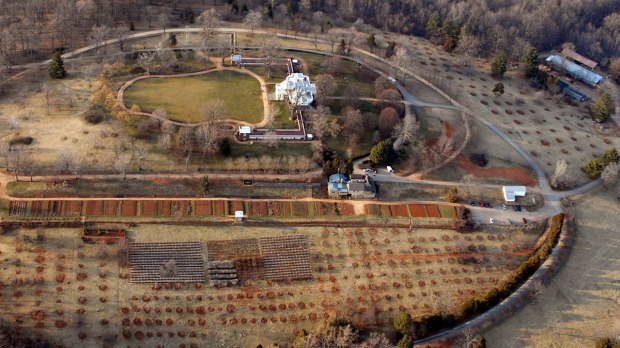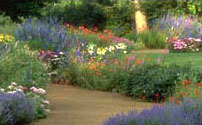Thomas Jefferson, Agriculturalist
I find that the limited number of our flower beds will too much restrain the variety of flowers in which we might wish to indulge, & therefore I have resumed an idea … of a winding walk … with a narrow border of flowers on each side. this would give us abundant room for a great variety.
– Thomas Jefferson to Anne Cary Randolph, June 7, 1807 1

In addition to the obvious accomplishments of Thomas Jefferson–president of the United States, author of the Declaration of Independence, inventor of, among other things, the hideaway bed and a copying machine so he could create multiple copies of his writings at one time, he also cared deeply about agriculture.

Thomas Jefferson
At least once a year, every year, when I lived in Virginia, I’d make a trek to Monticello, the home of Thomas Jefferson, near Charlottesville, VA. The house itself is beautiful and filled to the brim with Jefferson’s writings, his inventions, and marvelous things given to him during his years of prominence. History vibrates off the walls in the great hall, where people would wait for hours, or sometimes days, for an audience with the man.

The West Lawn of Monticello in Spring
But it’s the extensive Monticello gardens where I felt most at home. The rose beds, the kitchen gardens, the herbs, miles of flowers all around, always made me stop and take a minute to smell the roses, as the saying goes. I’d always head home with seeds cultivated from the garden and use them in my own, much less expansive yard. I took an immense pleasure in knowing the flowers in my back yard were grown from the same stock as Thomas Jefferson’s were. Twenty oval flower beds took shape after Jefferson retired from the public eye, each devoted to a different flower, and the Winding Walk defined the West lawn. Most of the flowers, seeds and bulbs were purchased from Bernard McMahon, owner of a nursery in Philadelphia and the subject of a previous post on this blog.

The Winding Walk
My most recent WIP deals with a fictional young American working for Thomas McMahon, a nursery owner in Philadelphia. Thomas’ father, Bernard, was one of only two nurseries Jefferson trusted with the care and nurturing of the plants and seeds brought back from the west by Lewis and Clarke. My character makes the trip to England to buy rose bushes and purchase the much needed seeds for Mr. Jefferson’s grounds as well as other lesser-known Americans. My days have been filled with learning about the rose beds, vegetable beds and other delights to be found at Monticello.

Map of Monticello
Jefferson divided his gardens into four unique categories: Flower Gardens, Vegetable Gardens, Fruit Gardens, and the unique features found in the landscape around the grounds. While my favorite is the flower gardens, I did see the wisdom in Mr. Jefferson having such an interest in vegetables and fruits. Since Jefferson had many visitors to Monticello, it was essential that he have sufficient food and drink to entertain his guests. He cultivated 330 varieties of vegetables in a 1,000 foot long terrace garden, which was convenient to the kitchen. His orchards contained 170 different varieties of fruit, including peaches, apples and grapes. In addition, he cultivated orange trees in a greenhouse on the grounds. He kept careful notations about the types of plants used in a comprehensive garden book. McMahon provided product from Europe as well as what he cultivated locally, and fully a quarter of the flowers grown in the Jefferson gardens was native to North America
.

Indian Blood Cling Peaches

Jefferson’s Vineyards

Layout of the Orchards
The flower gardens almost disappeared following Jefferson’s death in 1826, when the grounds and the house fell into disrepair. Fortunately, both have been restored to their original splendor, the grounds by the Garden Club of Virginia, which undertook the task between 1939 and 1941. Jefferson had made sketches of the Winding Walk flowerbeds along the west lawn and the twenty oval beds included there. Many of the bulbs that were planted during Jefferson’s time remained and continued to flower, so an outline of Jefferson’s vision was already in the ground, just waiting to be found again.

The Flower Walk
With summer just around the corner, gardens all over the country are finally coming to life. It’s a great time to visit Monticello and buy some seeds harvested from the gardens. Be sure to take enough time to tour the grounds and get some inspiration to use in your own backyard.

The Garden Shop at Monticello
- Coolidge Collection of Thomas Jefferson Manuscripts, Massachusetts Historical Society. Transcription available at Founders Online.
https://www.monticello.org/site/house-and-gardens/historic-gardens
https://en.wikipedia.org/wiki/Gardens_of_Monticello
Love Virginia. Love Thomas Jefferson. Went to school at both William and Mary and UVA. And enjoyed a visit to Monticello with my father and my husband and children in 2010. Gorgeous! Thank you for a post that brought back many happy memories.
LikeLike
Thanks for stopping by today, SJ. I’m glad it brought back memories for you. I want to go again soon.
LikeLike
I’m going there next weekend! How fun to see this blog!
LikeLike
You’ll have a blast, Petie! Wish I could squeeze in a visit this year.
LikeLike
Monticello is such a lovely place and Jefferson was such an amazing man. One can but wonder what he would think of the world today. Would he marvel at all of the technology or be disturbed by how it has taken on a life of its own?
LikeLike
I’m sure Jefferson would have found a way to adjust and even create, in today’s technological world.
LikeLike
We’ve also enjoyed several visits to Monticello. I grew up admiring Jefferson, magnificent, brilliant, complex, and flawed man that he was. Great mind. Spectacular insights. Spectacular blind spots and weaknesses. The picture of him in David McCullough’s John Adams shed all sorts of new lights for me. And oh yes! The gardens are spectacular. (Smile) I am reminded of John Kennedy’s statement when hosting Nobel laureates at the White House, “I think this is the most extraordinary collection of talent, of human knowledge, that has ever been gathered at the White House – with the possible exception of when Thomas Jefferson dined alone.”
LikeLike
I love the Kennedy quote about Jefferson. Have never heard that one before, but I feel the same way. Thanks for sharing, Caroline.
LikeLike
I’ve never been to Monticello. I guess I should put it on my list of travels once I move back to the southeast where I belong. I’m going to dive into Jefferson’s religious beliefs within the next six months or so. That should be interesting.
LikeLike
I encourage you to visit, especially if you’re studying his religious beliefs. What better way to get a sense of the man?
LikeLike